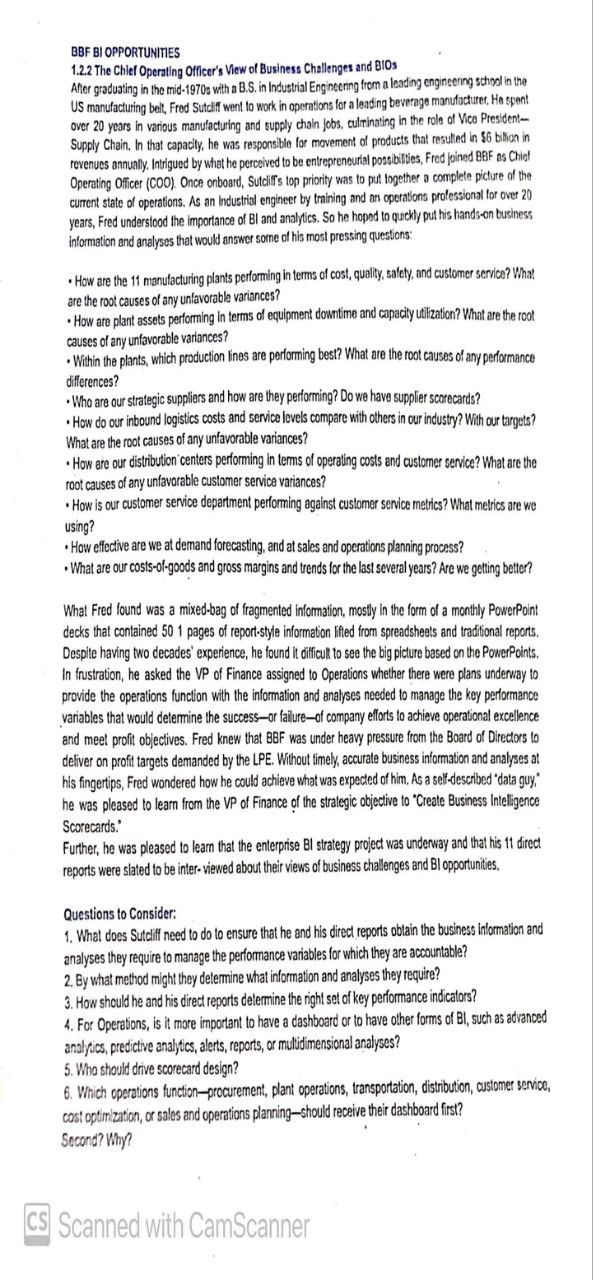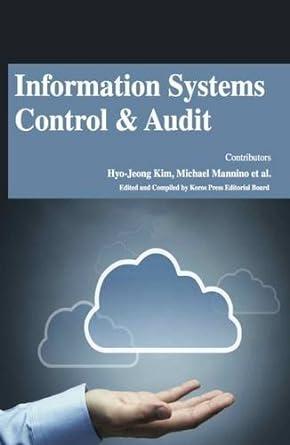Answered step by step
Verified Expert Solution
Question
1 Approved Answer
BBF BI OPPORTUNITIES 1.2.2 The Chief Operating Officer's View of Business Challenges and BIOs Afer graduating in the mid-1970s with a B.S. in Industrial Engincenng
 BBF BI OPPORTUNITIES 1.2.2 The Chief Operating Officer's View of Business Challenges and BIOs Afer graduating in the mid-1970s with a B.S. in Industrial Engincenng from a leading engineering sctiod in the US manufacturing belt, Fred Sutclif wert to work in operations for a leading beverage manufocture, Ho spen! over 20 years in various manulacturing and supply chain jobs. culrinating in the role of Vico PresidentSupply Chain, In that capacty, he was responsible for movement of products that resuled in \\( \\$ 6 \\) bilion in revenues annually. Intrigued by what he perceived to be entrepreneurial possibilies, Fred joined BBF as Chial Operating Officer (COO). Once onboard, Sutciffs top priority was to put logether a complete picture of the current state of operations. As an Industrial engineer by training and an operations prolessional for over 20 years, Fred undersiood the importance of \\( B I \\) and analyics. So he hopod to quekly put his hands-on business information and analyses that would answer sorne of his most pressing questions: - How are the 11 manulacturing plants performing in terms of cost, quality, sa'cty, and customet service? What are the root causes of any unfavorable variances? - How are plant assets performing in terms of equipment downtime and capacity utilization? What are the root causes of any unfavorable variances? - Within the plants, which production lines are performing best? What are the root causes of any performance differences? -Who are our strategic suppliers and how are they performing? Do we have supplier scorecards? - How do our inbound logistics costs and service levels compare with others in our industry? With our targets? What are the root causes of any unfavorable variances? - How are our distribution centers performing in terms of operating costs and customer service? What are the root causes of any unfavorable customer service variances? - How is our customer service department performing against customer service metrics? What metrics are we using? - How effective are we at demand forecasting, and at sales and operations planning process? -What are our costs-ol-goods and gross margins and trends for the last several years? Are we getting betten? What Fred found was a mixed.bag of fragmented information, mostly in the form of a monthly PowerPoint decks that contained 501 pages of report-style information lifted from spreadsheats and tradifional reports. Despite having two decades' experience, he found it dificult to see the big picture based on the PowerPoints. In frustration, he asked the VP of Finance assigned to Operations whether there were plans underway to provide the operations function with the information and analyses needed to manage the key performanoe variables that would determine the success-or failure-of company eflorts to achieve operational excellence and meel profit objectives. Fred knew that BBF was under heaw pressure from the Board of Directors to defiver on profit targets demanded by the LPE. Without timely, accurate business information and analyses at his fingertips, Fred wondered how he could achieve what was expected of him, As a sell-described \"data guy,\" he was pleased to learn from the VP of Finance of the stralegic objective to \"Create Business Intelligence Scorecards.\" Further, he was pleased to learn that the enterprise BI strategy project was underway and that his 11 dired reports were slated to be inter- viewed about their views of business challenges and BI opportunities, Questions to Consider: 1. What does Sutcliff need to do to ensure that he and his direct reports oblain the business inlormation and analyses they require to manage the performance variables for which they are accountable? 2. Ey what method might they determine what information and analyses they require? 3. How should he and his direct reports delermine the right sel of key performance indicators? 4. For Operations, is it more important to have a dashboard or to have other forms of BI, such as advanced analyics, predictive analytics, alerts, reports, or mulidimensional analyses? 5. Who should drive scorecard design? 6. Which operations function-procurement, plant operations, transportation, distribution, customer servico, cost optirnzation, or sales and operations planning-should receive their dashboard first? Second? Why
BBF BI OPPORTUNITIES 1.2.2 The Chief Operating Officer's View of Business Challenges and BIOs Afer graduating in the mid-1970s with a B.S. in Industrial Engincenng from a leading engineering sctiod in the US manufacturing belt, Fred Sutclif wert to work in operations for a leading beverage manufocture, Ho spen! over 20 years in various manulacturing and supply chain jobs. culrinating in the role of Vico PresidentSupply Chain, In that capacty, he was responsible for movement of products that resuled in \\( \\$ 6 \\) bilion in revenues annually. Intrigued by what he perceived to be entrepreneurial possibilies, Fred joined BBF as Chial Operating Officer (COO). Once onboard, Sutciffs top priority was to put logether a complete picture of the current state of operations. As an Industrial engineer by training and an operations prolessional for over 20 years, Fred undersiood the importance of \\( B I \\) and analyics. So he hopod to quekly put his hands-on business information and analyses that would answer sorne of his most pressing questions: - How are the 11 manulacturing plants performing in terms of cost, quality, sa'cty, and customet service? What are the root causes of any unfavorable variances? - How are plant assets performing in terms of equipment downtime and capacity utilization? What are the root causes of any unfavorable variances? - Within the plants, which production lines are performing best? What are the root causes of any performance differences? -Who are our strategic suppliers and how are they performing? Do we have supplier scorecards? - How do our inbound logistics costs and service levels compare with others in our industry? With our targets? What are the root causes of any unfavorable variances? - How are our distribution centers performing in terms of operating costs and customer service? What are the root causes of any unfavorable customer service variances? - How is our customer service department performing against customer service metrics? What metrics are we using? - How effective are we at demand forecasting, and at sales and operations planning process? -What are our costs-ol-goods and gross margins and trends for the last several years? Are we getting betten? What Fred found was a mixed.bag of fragmented information, mostly in the form of a monthly PowerPoint decks that contained 501 pages of report-style information lifted from spreadsheats and tradifional reports. Despite having two decades' experience, he found it dificult to see the big picture based on the PowerPoints. In frustration, he asked the VP of Finance assigned to Operations whether there were plans underway to provide the operations function with the information and analyses needed to manage the key performanoe variables that would determine the success-or failure-of company eflorts to achieve operational excellence and meel profit objectives. Fred knew that BBF was under heaw pressure from the Board of Directors to defiver on profit targets demanded by the LPE. Without timely, accurate business information and analyses at his fingertips, Fred wondered how he could achieve what was expected of him, As a sell-described \"data guy,\" he was pleased to learn from the VP of Finance of the stralegic objective to \"Create Business Intelligence Scorecards.\" Further, he was pleased to learn that the enterprise BI strategy project was underway and that his 11 dired reports were slated to be inter- viewed about their views of business challenges and BI opportunities, Questions to Consider: 1. What does Sutcliff need to do to ensure that he and his direct reports oblain the business inlormation and analyses they require to manage the performance variables for which they are accountable? 2. Ey what method might they determine what information and analyses they require? 3. How should he and his direct reports delermine the right sel of key performance indicators? 4. For Operations, is it more important to have a dashboard or to have other forms of BI, such as advanced analyics, predictive analytics, alerts, reports, or mulidimensional analyses? 5. Who should drive scorecard design? 6. Which operations function-procurement, plant operations, transportation, distribution, customer servico, cost optirnzation, or sales and operations planning-should receive their dashboard first? Second? Why Step by Step Solution
There are 3 Steps involved in it
Step: 1

Get Instant Access to Expert-Tailored Solutions
See step-by-step solutions with expert insights and AI powered tools for academic success
Step: 2

Step: 3

Ace Your Homework with AI
Get the answers you need in no time with our AI-driven, step-by-step assistance
Get Started


